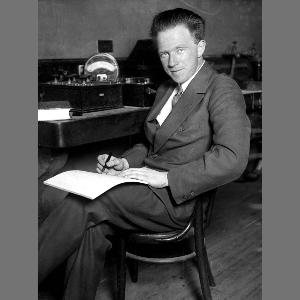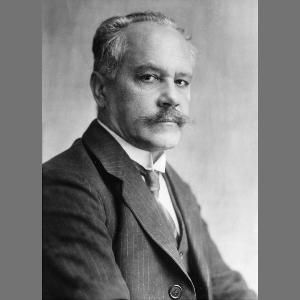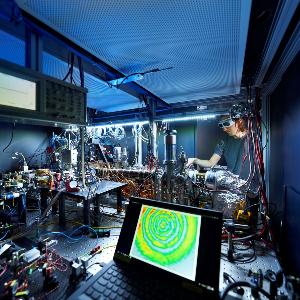Quantum Year 2025: the world seen anew
20 Feb 2025
How quantum mechanics revolutionized thought 100 years ago. An interview with Ulrich Schollwöck, Dean of the Faculty of Physics at LMU and member of MCQST.
20 Feb 2025
How quantum mechanics revolutionized thought 100 years ago. An interview with Ulrich Schollwöck, Dean of the Faculty of Physics at LMU and member of MCQST.
A hundred years have passed since the formulation of quantum mechanics in 1925. To honor this event, the United Nations have declared 2025 the International Year of Quantum Science and Technology. At LMU, the Faculty of Physics and the Cluster of Excellence MCQST are organizing numerous events as part of the Quantum Year 2025.
Professor Ulrich Schollwöck, Dean of the Faculty of Physics at LMU and member of the Cluster of Excellence MCQST, talks about the beginnings of quantum mechanics, discusses what role researchers in Munich played and how to convey concepts like entanglement to young people today.
Max Planck used the term ‘quanta’ for the first time in 1900. Most physicists presumably did not understand the concept at the time and many people do not really understand it to this day. What are quanta?
Ulrich Schollwöck: This brings us to the heart of the whole dilemma. It’s very difficult to find a standard definition, because the concepts of quantum physics do not have a direct connection to our everyday experiences. To give an example, it’s often said that light is a wave and a particle. In reality, it’s neither one nor the other. It’s something entirely different and sui generis. Under certain experimental conditions – optical interference, for instance – it manifests itself only in a way that we would interpret as a wave. Under other conditions – in the case of photo detectors, for example, such as found in smartphone cameras – they manifest as particles. Here, individual photons are detected and added up. For light, nature behaves like an abstract object between wave and particle, as it were, and that’s hard to comprehend.
Albert Einstein also investigated the nature of light and the wave-particle question. In 1905, he proposed the concept of light energy quanta.
Einstein considered his work on the quantization of light to be his most revolutionary. This is a view I share and think he deservedly won the Nobel Prize for just this achievement. Since the 17th century at least, physicists have been seriously discussing the nature of light, the question of particles or waves. After the work of James Clerk Maxwell around 1860, the matter seemed to be settled in favor of waves – and the theory more or less wrapped up. Then in 1905, with an idea that was simple but all the more ingenious for that, Einstein showed that light must be thought of as a sort of gas of particles under certain circumstances.
What did Einstein mean by the term ‘energy quanta’?
Max Planck had shown in 1900 that certain properties of electromagnetic radiation cannot be understood if we assume that the energy can be transported in continuous quantities. Instead, matter can absorb and emit energy only in fixed, precisely defined quantities. These quantities of energy were known as quanta – with a quantum of energy being akin to a little energy packet. Einstein’s big step in 1905 was to recognize that the existence of these packets is not connected to this absorption and emission process – after all, that could be a property of the material alone – but that energy quanta reflect a fundamental property of light itself. Light occurs only in these fixed, quantized packets of energy.
Why was this concept so revolutionary?
Because prior to that, the prevailing notion was that physical processes are continuous in nature, that energy can be absorbed or emitted in quantities of any amount. The idea that there was a granular structure buried within was completely revolutionary. There were big debates, with scientific luminaries on both sides. Figures like Ernst Mach and the chemist and Nobel laureate Wilhelm Ostwald were major opponents of the atomic hypothesis, as it was known at the time. A major proponent, by contrast, was our very own Ludwig Boltzmann – the first Professor of Theoretical Physics at LMU.
Is it not more accurate, then, to say that quantum physics was born in 1900?
It was more of a preliminary stage. The ideas of both Einstein and Max Planck still revolved around concepts from classical physics. You can even see this in Niels Bohr’s model of the atom from 1913, which was still predicated on the idea that electrons orbited around atomic nuclei, like the planets around the sun. The Bohr model was perfected by Arnold Sommerfeld in Munich in 1916, but all physicists back then remained stuck in the old conceptual framework. The major change arrived in 1925, with the creation of a coherent quantum theory that did not rely on classical concepts.
The major change arrived in 1925, with the creation of a coherent quantum theory that did not rely on classical concepts.Ulrich Schollwöck

Quantum physicist Werner Heisenberg at the age of 28 | © IMAGO/TT
What made this year 1925 so special?
The flurry of dramatic new insights begins with Werner Heisenberg, who, after obtaining his doctorate at LMU under Sommerfeld, went to Göttingen to work as an assistant to Max Born. Because of his hay fever, he found himself on the North Sea island of Helgoland in June 1925, where, as the story goes, he had the idea of a brand new way of describing these atomic processes. This would result in what became known as matrix mechanics, as the use of matrices greatly simplified his formalism. Then, in the fall of 1925, Heisenberg, working with Born and Pascual Jordan, developed the idea into a logically coherent structure. This structure was mathematically stable and proceeded from the philosophical premise that observation was the only thing that counts – in other words, the formalism describes observations.
Then physicist Erwin Schrödinger entered the scene.
Exactly, at the end of the year, Schrödinger took a vacation in the Swiss Alps, where he stayed in a cabin with a female companion, of whom the only thing we know to this day is that she was not his wife. He returned from this sojourn with his famous wave function and wave equation. Factional disputes initially ensued in 1926 between Heisenberg’s matrix mechanics and Schrödinger’s wave mechanics. It quickly became apparent, however, that they are mathematically equivalent in the final analysis.
In your view, did the main progress consist in finding a new language to express what Planck, Einstein, and others had previously thought, but had still formulated in an older mode of thinking?
Indeed, the decisive step was cutting the umbilical cord to the concepts of classical physics, such as the trajectory concept. In quantum mechanics, the electron is no longer conceived of as a kind of little sphere moving through the universe. Instead, the wave function states the probability that it is currently located at a particular place in the universe. At the beginning, it wasn’t at all clear what this wave function means, that it is a statement about probability of location. Schrödinger himself initially believed we can conceptualize this as a kind of fuzzy reality – that is to say, something not precisely localizable.
Why did the discoveries of 1925 come so hard and fast? What was in the air?
This is a question that has prompted much debate among scientists. Some maintain that after the First World War, the intellectual climate was ripe for a probabilistic, as opposed to deterministic, view of the world. Heisenberg often invoked his predisposition to Platonic Idealism. This came from the classical education he received at the Max Gymnasium grammar school here in Munich, which fostered within him a highly abstract, indirect view of the world.

Arnold Sommerfeld, theoretical physicist, trained a whole generation of renowned physicists at LMU, including numerous Nobel Prize winners. | © picture alliance / ullstein bild
The Faculty of Physics at LMU made a relatively large contribution to quantum theory, with physicist Arnold Sommerfeld playing a leading role.
Yes, Arnold Sommerfeld is the key figure here in Munich. The Faculty of Physics at LMU was designated a Historic Site by the European Physical Society for its contributions. We’ve had outstanding experimental physicists here like Wilhelm Röntgen, Willi Wien, Max von Laue, and later Walther Gerlach. For his part, Sommerfeld founded a school of theoretical physics and counted among his students no fewer than twelve Nobel laureates as well as many other world-famous physicists. To this day, incidentally, he is the physicist to have received the most nominations for a Nobel Prize without ever winning one. Apparently, Niels Bohr prevented him.
What was his recipe for success?
Sommerfeld made sure that his seminar students systematically worked through the latest research literature. In this way, he was able to attract and retain the best researchers when they were young, including his great pupils, Heisenberg, Wolfgang Pauli, and Hans Bethe. In one of the first major practical applications of quantum theory, Pauli collaborated with Sommerfeld to elaborate a quantum theory of metals, which explained the properties of metals for the first time. This was the accomplishment for which Sommerfeld should really have been awarded the Nobel Prize. Hans Bethe was subsequently head of the theoretical division at Los Alamos. The list goes on and on. Munich’s contribution was primarily about setting these people on the right track.

Quantum simulation in the laboratory of physicist Monika Aidelsburger at the LMU in Schellingstraße | © Christoph Hohmann / MCQST
What are the lessons we can learn from this success story today?
LMU and the Munich region are considered one of the main centers of modern quantum physics. This becomes apparent when we think of the MCQST Cluster of Excellence and the support provided in the Munich Quantum Valley. But ultimately, such things are the rewards for accomplishments that have already been realized or are in the making. I think Sommerfeld’s approach – introducing students to the latest research as soon as possible – remains the wellspring of future excellence. The same goes for gathering the brightest minds here, as Sommerfeld was so adept at doing. Although innovations cannot be planned, they tend to come from researchers who are tuned into what’s special and new in quantum physics. The great thing here is that everything grew from the ground up, as opposed to being planned from the top down.
What are you especially proud of?
Here in Munich, we kicked off the development of quantum simulators, or analog quantum computers as they are sometimes called. These machines allow us to experimentally investigate very many questions in many-body physics, and thus not just the quantum mechanics of individual particles, in a targeted and systematic manner. This is an innovation, by the way, that began right here in Schellingstrasse, on the floor beneath my office. The prime movers in the famous experiment from 2002 at the chair of Ted Hänsch were Immanuel Bloch and Tilman Esslinger. The field of quantum communication and quantum cryptography under the leadership of Harald Weinfurter is another example: We’re currently working with colleagues from the Technical University of Munich (TUM) on a quantum network that connects downtown Munich with Garching. Such projects are unique worldwide. Munich is also one of the leading players in the field of quantum sensors, where the work is often a combination of basic research and potential applications.
At MCQST, there’s a lot of talk of quantum technology 2.0. What does this mean?
Many of our modern technologies today are already based on quantum technology: transistors, the key components in all kinds of devices, rely on a quantum mechanical effect. But now we’re attempting to exploit something that quantum physicists call entanglement. This is a phenomenon that’s radically different from our familiar classical world of perception. It means that information in the universe, to an overwhelming extent, does not occur locally. Our classical notions consider this sheet of white paper on the table as separate from the black chair on which I’m sitting. We associate information locally. At the level of the macroscopic world, this makes sense. But at the microscopic level, the substrate of our reality, information occurs almost exclusively in a non-localized fashion. Scientists are now trying to exploit this effect for new applications. In quantum computing, this is extremely laborious and complicated, as it requires entangling very, very many objects. This is a steep path researchers are taking, because in our familiar macroscopic world, there’s a strong tendency in nature to eliminate the non-locality of information.
The quantum world is not at all easy to grasp. How can principles like entanglement or superposition be explained to the general public?
That’s certainly true. To help, we often reach for metaphors – say, that two objects ‘know’ about each other even though they cannot exchange any information about their states. Mathematically, entanglement has a relatively simple structure. This illustrates, by the way, that the use of mathematics in the natural sciences is not about inventing a secret language. In fact, mathematical concepts make everything much simpler.
To mark this Quantum Year at LMU and MCQST, you’ve undertaken to prepare quantum mechanical discoveries for presentation to the general public.
Yes, it’s all systems go. We’re participating in the Quantenwochenende im Deutschen Museum for example, for which we co-developed the “Light and Matter” exhibition, which has already attracted several hundreds of thousands of visitors. It will shortly become part of the permanent exhibition there, which is quite an honor. At LMU, there will be a series of public lectures at the Faculty of Physics, and in November we will have the Day of Quantum Physics. We’re also going out to schools. In Garching, we have the Photon Lab at the Max Planck Institute of Quantum Optics, which offers school groups practical glimpses into quantum physics. In addition, Jochen Kuhn has developed a laboratory for schoolchildren.
So you’re reaching out to youngsters in particular.
Precisely. And the response we’re getting shows how well it’s working. The Photon Lab of Silke Stähler-Schöpf is booked out long in advance. We could do much more if we had the resources. And this would be to our own benefit, as these young people are our future. This includes young children, with their untrammeled curiosity. It is easy to spark their interest in scientific questions. Schoolchildren are our doctoral researchers of tomorrow, without whom no innovation would be possible and where a fresh, open spirit of inquiry, unburdened by preconceptions, is invaluable. One of my goals is for us to redouble our efforts to inspire an interest in science at an even earlier age, in elementary school. My impression, and one that is shared by many learning psychologists, is that gifted young girls are being lost to science in particular already at elementary school age. I’ve got nothing against Girls Days and similar events, but I’m of the opinion that they come too late. We must preserve the enthusiasm that seems to be present in four or five year olds relatively independent of gender.
What expectations do you have of the Quantum Year as Dean of the Faculty of Physics and member of the MCQST Cluster of Excellence? What are you looking forward to the most?
Firstly, that we seek to convey some of the mysteries of the quantum world to a broader public, even if we know it won’t be easy. As quantum physicists, we hope of course that we continue to receive support for our research. Ultimately, we live off the taxpayer, and it’s important that we strive to pass on our passion for quantum physics to young people. The youngsters we manage to inspire could well be the ones making the next big innovations in 10 or 15 years’ time. The world of quantum physics is still vast, with much that remains to be understood. In a sense, we’re still at the beginning of the story, even after a century of progress.
A large number of events on the subject of quantum physics will take place at LMU in 2025. The events are aimed at the general public as well as teachers and students.